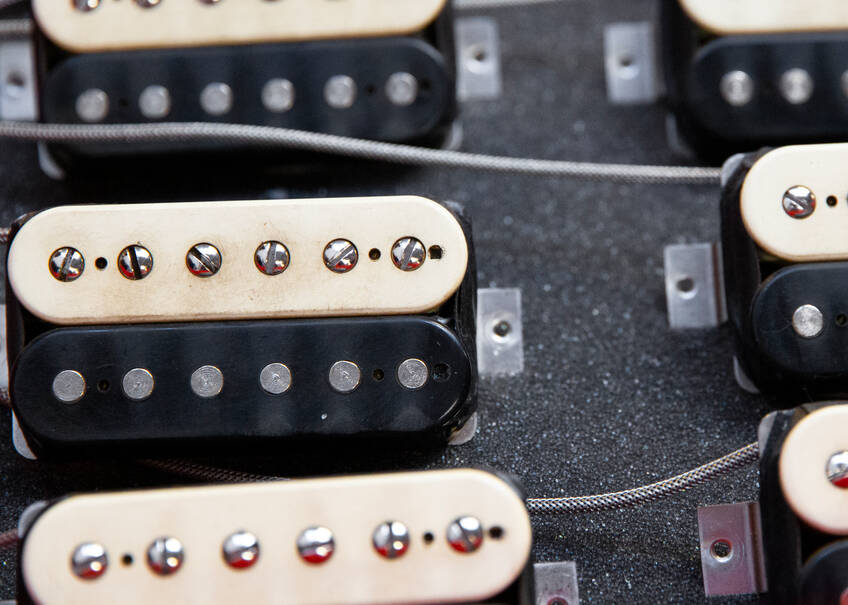Tech Tips: Magnet Types
20th April 2020
Choosing The Best Magnets To Voice A Pickup


Whether it's to accurately recreate a vintage recipe, or to dial in a certain feel for a contemporary model, the choice of magnet plays a major role in the overall voicing and dynamic range of a pickup. We use a variety of alnico (Aluminium/Nickel/Cobalt) grades, as well as ceramics to craft the best voicing for each model. indeed, sometimes we even mix different magnet types together in one pickup, such as the alnico V and ceramic combination of the Juggernaut bridge humbucker.
Alnico grades are numbered (typically shown in roman numerals) and are defined by differing proportions of their constituent metals. We use Alnico II, III, IV and V in a wide range of our pickup models. There are further variances within those alnico grades, though, as there are also some differences in the crystalline structure of the magnet which affects how its magnet field forms. Magnets with a more uniform crystaline structure will tend to be "anisotropic" which means that they have a preferred plane of magnetisation and will have a more ordered field with a stronger pull. More disorderly crystaline structure will tend to create an "isotropic" magnet, which can be magnetised in multiple directions, and makes for a more scattered magnetic field. Some of the weaker alnico grades will tend to be more isotropic.
Ceramic magnets also come in a variety of grades, but we only use ceramic 8, which offers a really useable step up in power from the alnico grades.
So, how do we choose the right magnet for the job? Well, here's some wisdom from Bare Knuckle Founder Tim Mills, from our forum:


"Magnets do add to the character of a pickup although it must be understood that a magnet doesn't have a sound on it's own, it contributes by the way it accentuates certain frequencies as current is produced in the coil windings.
Alnico II is the softest and generally has a smooth bass and treble although this is more pronounced the hotter the windings get.
Alnico III is very transparent, low output and clean,sounds great for rounded fat jazz applications-typical of '50s tone.
Alnico IV is probably the best vintage tone IMHO(for humbuckers) and along with II and III was used in the earliest PAFs-this is a fact and not myth as we've had them analysed and a collegue of mine has also seen original Gibson purchase orders that clearly state AIV bar stock being purchased.The tone of AIV is balanced and extremely organic, it produces the most authentic vintage tone and sits better in slightly hotter vintage winds than AII which tends to get very soft in the bass and highs if used incorrectly.
Finally Alnico V is the hottest producing more highs and lows, great for rock applications or where power and cut are important.
We also use ceramic 8 as do most pickup makers - it is more powerful and essentially more efficient so the resulting tone usually has a very fast tracking bass response with a distinct cut in the highs.Some players find them cold/hard when run clean and they can cause alot of compression from their relatively hot output-again, depending on how you use them, they are capable of good clean tones too but the general consensus is that Alnicos are sweeter run clean.
Different companies use different grades for personal reasons, we use all of the applicable Alnico grades to suit the correct design, both to be historically correct but more importantly to have the best sound.
Changing magnets in a humbucker can give dramatic results, you soon find the ones that really don't sit right and others that are head and shoulders better.Obviously you can't swap out single coil magnets as they're integral to the coil form.
I've personally spent alot of time voicing all the BKP range with the correct magnets but I do tweak and swap sometimes on consultation with a customer with a specific requirement."
Ultimately, designing a perfectly voiced pickup for a certain task is a balancing act between the magnet type, grade, size and configuration and the design and spec of the coil. Having a good handle on which magnet grades excel in certain configurations is a key skill in making those combinations work, time after time.
I hope that's given you some good info on what goes into selecting the best magnet for a pickup design. If you have any further questions, or you need some help finding the best pickup for your playing style, please drop us a line.

